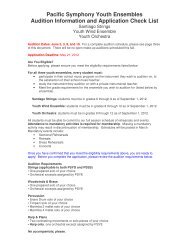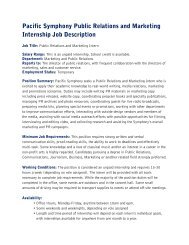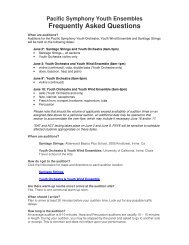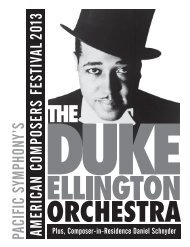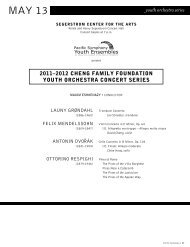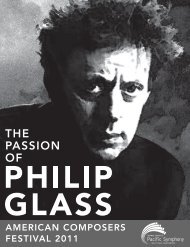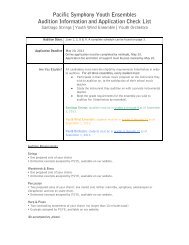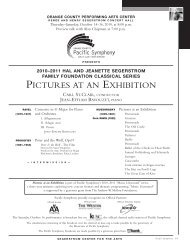Class Act Handbook 2012-2013 - Pacific Symphony
Class Act Handbook 2012-2013 - Pacific Symphony
Class Act Handbook 2012-2013 - Pacific Symphony
Create successful ePaper yourself
Turn your PDF publications into a flip-book with our unique Google optimized e-Paper software.
Lesson Set-up Check List<br />
√ Accessible outlet<br />
√ Table or desk<br />
√ Chair and music stand for musician<br />
√ Masking tape or push pins (for hanging visuals on the board)<br />
√ Chalk or Whiteboard<br />
√ Extension cord<br />
√ Water for musician<br />
√ Additional Refreshments (not required, but appreciated)<br />
√ Additional set-up requests, as discussed in Scheduling Meeting<br />
The Parent and Ambassador’s Lesson Checklist<br />
Orff lessons require a much more active commitment from Parents and Ambassadors.<br />
These invaluable volunteers should be prepared to follow the guidelines below as they<br />
help facilitate the lesson and serve as the musician’s assistant<br />
One set up is complete, ask the musician how they would like the students seated once<br />
they arrive<br />
As students and teacher arrive, enlist the teacher’s help in directing the students to the<br />
appropriate seating configuration (as indicated by the musician)<br />
Open the lesson with a very brief remarks, no more than three or four sentances See<br />
suggested script below for more details<br />
During the lesson, the musician will indicate when he/she needs assistance. This might<br />
include handing out instruments, modeling specific movements, singing along, or<br />
assisting students<br />
Another helpful way to assist the musician is to ensure that ALL adults in the room<br />
are modeling appropriate participatory behavior and assisting with students as needed<br />
Once the musician indicates that the lesson is complete (lesson last 30 minutes) assist<br />
him/her in collecting any instruments and props<br />
Close the lesson with brief closing remarks. See suggested script below for more<br />
details<br />
Suggested Opening and Closing Remarks<br />
Opening remarks should be brief, no more than three to four sentances. The purpose is<br />
to settle the class and focus them on the musician. Closing remarks should also be<br />
brief. Use this script as a guideline, but also feel free to create your own, personalized<br />
text. You might also want to mention who you are (Ambassador, PTA President, your<br />
child’s mother etc.) and adjust content as appropriate for the students’ age.<br />
Opening Remarks<br />
Good Morning! My name is _______________ . It’s an exciting day today, because<br />
you are going to have your (first/second/third) lesson with (Musician’s Name).<br />
(Musician’s Name) is one of two <strong>Pacific</strong> <strong>Symphony</strong> musicians who are visiting our<br />
school this year to teach us all about Camille Saint-Saëns and Endless Imagination.<br />
(If this is the second or third lesson, you may want to review what students learned in<br />
the first/second lesson). Let’s welcome (Musician’s Name)!<br />
59



